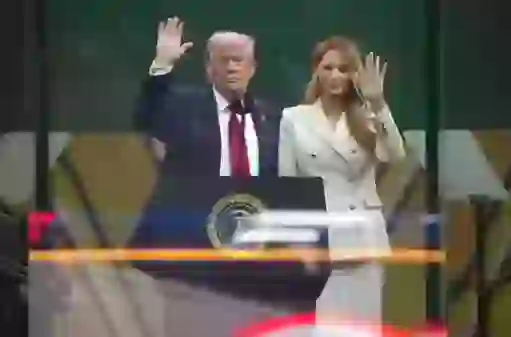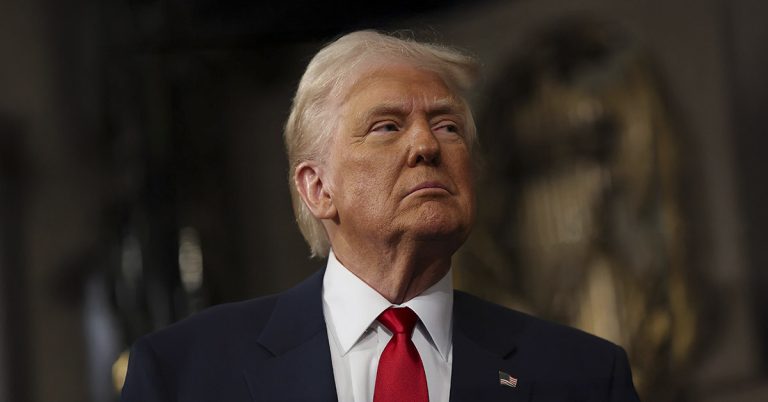
Melania’s Unusual Parade Behavior Ignites Talk of ‘Double’ Conspiracy
THE PHANTOM FIRST LADY: INSIDE THE PERSISTENT CONSPIRACY THEORY THAT REFUSES TO DIE AND WHAT IT REVEALS ABOUT MODERN POLITICAL CULTURE
In the labyrinthine world of contemporary conspiracy theories, few have demonstrated the remarkable persistence and adaptability of the “Fake Melania” phenomenon—a digital age urban legend that transforms every public appearance by the First Lady into a subject of intense scrutiny, forensic analysis, and speculative interpretation. What began as a seemingly offhand observation by a journalist has evolved into a self-sustaining ecosystem of amateur detectives, social media sleuths, and armchair analysts who have appointed themselves guardians of an alternate reality where body doubles, political theater, and marital deception intersect.
The recent military parade commemorating the Army’s 250th anniversary, which coincided with President Trump’s 79th birthday celebration, provided yet another opportunity for conspiracy theorists to exercise their analytical muscles on the enigmatic figure of Melania Trump. Her appearance at this elaborate ceremony—estimated to have cost $45 million and featuring over 6,000 military personnel—reignited discussions that have simmered beneath the surface of American political discourse for years, revealing as much about our collective psychology as they do about the subjects of investigation.
THE GENESIS OF A DIGITAL AGE MYTH
The “Fake Melania” conspiracy theory represents a fascinating case study in how modern conspiracy theories emerge, evolve, and sustain themselves through digital platforms and social media ecosystems. Unlike traditional conspiracy theories that might take years or decades to develop and spread, the Melania replacement theory achieved viral status almost instantly, demonstrating the accelerated pace of myth-making in the internet age.
The theory’s origins can be traced to a 2017 tweet by a Guardian journalist who made what appeared to be a casual observation about the First Lady’s authenticity during public appearances. The tweet, which read “Absolutely convinced Melania is being played by a Melania impersonator these days. Theory: she left him weeks ago,” struck a chord with audiences who had already been speculating about the First Lady’s apparent reluctance to embrace traditional political spouse roles.
What transformed a single tweet into a persistent conspiracy theory was the perfect storm of existing public skepticism, readily available digital analysis tools, and the First Lady’s own enigmatic public persona. Melania Trump’s limited public appearances, her apparent discomfort in certain political settings, and her overall approach to the First Lady role had already created an information vacuum that conspiracy theories naturally rushed to fill.
The viral nature of the original tweet demonstrated how social media platforms can amplify individual observations into mass movements almost instantaneously. Within hours, thousands of users were sharing, commenting, and adding their own analyses to the growing body of “evidence” supporting the replacement theory.
The democratization of image analysis through smartphone technology and social media platforms enabled ordinary citizens to become amateur forensic analysts, examining photographs and videos with a level of detail that would have been impossible for most people in previous media eras.
THE MECHANICS OF MODERN CONSPIRACY ANALYSIS
The persistence of the “Fake Melania” theory reveals sophisticated analytical techniques that contemporary conspiracy theorists employ to support their beliefs while maintaining plausible deniability about the extraordinary nature of their claims. These techniques have evolved far beyond simple speculation to encompass pseudo-scientific methodologies that lend an air of legitimacy to otherwise fantastic assertions.
Facial analysis has become a cornerstone of the replacement theory, with believers comparing photographs from different events to identify supposed inconsistencies in facial structure, expressions, and proportions. These analyses often focus on minute details like nose shape, eye spacing, smile patterns, and even perceived changes in height or body proportions between appearances.
Behavioral analysis represents another significant component of conspiracy theorist methodology, with believers cataloging and comparing Melania’s mannerisms, gestures, and interactions across different public events. Variations in behavior—whether due to mood, context, fatigue, or simple human variability—are interpreted as evidence of different individuals playing the same role.
The technology available to amateur analysts has enhanced their capabilities significantly, with high-definition video, photograph enhancement software, and frame-by-frame analysis tools enabling detailed examination that rivals professional forensic techniques. This technological democratization has created a new class of citizen investigators who feel empowered to challenge official narratives.
Crowdsourced analysis through social media platforms enables collaborative investigation where multiple individuals contribute observations, theories, and supporting evidence. This collective approach creates a sense of shared discovery and validation that strengthens belief in conspiracy theories while making them more resistant to debunking efforts.
THE SATURDAY PARADE: A NEW CHAPTER IN CONSPIRACY LORE
The military parade on Saturday, June 14, provided conspiracy theorists with fresh material for analysis while demonstrating how established theories adapt to incorporate new evidence and circumstances. Melania’s appearance at this high-profile event, unobscured by her characteristic oversized hats or sunglasses, was initially seen as an opportunity for definitive analysis.
The parade setting created unique observational opportunities, with multiple camera angles, extended coverage, and various lighting conditions providing conspiracy theorists with hours of footage to examine. The formal nature of the military ceremony meant that Melania was visible for extended periods, allowing for behavioral analysis across different moments and contexts.
Early footage from the parade showed the First Lady appearing engaged and animated, smiling and seemingly enjoying the ceremonial proceedings. However, later clips revealed moments where she appeared less interested or even potentially drowsy, creating the kind of behavioral variation that conspiracy theorists often interpret as evidence of multiple individuals.
Social media analysis of the parade footage revealed the sophisticated techniques that modern conspiracy theorists employ to support their theories. Users provided detailed examinations of facial features, body language, clothing choices, and interaction patterns, creating comprehensive analytical frameworks that resembled academic research in their thoroughness and attention to detail.
One particularly detailed social media analysis noted perceived changes in the First Lady’s appearance, writing: “Don’t think that’s really Melania Trump… she seems nice and warm and older and wider… is that a body double?!!” This observation encapsulated the kind of minute analysis that characterizes contemporary conspiracy theorizing.
The parade analysis also revealed how conspiracy theories adapt to incorporate contradictory evidence. When early footage showed Melania appearing engaged and authentic, theorists suggested that this might represent the “real” Melania making a rare appearance. When later footage showed her appearing less interested, this was interpreted as either fatigue affecting the real Melania or evidence of a replacement taking over.
THE PSYCHOLOGY OF SUBSTITUTE REALITY
The persistence of the “Fake Melania” conspiracy theory reveals important insights into the psychological mechanisms that sustain alternative explanations for public events and personalities. These mechanisms operate independently of factual evidence, creating self-reinforcing belief systems that become more elaborate and resistant to contradiction over time.
Pattern recognition, a fundamental human cognitive ability, becomes hyperactive in conspiracy theorizing, leading believers to identify meaningful connections and variations in what are likely random or contextual differences. The human brain’s tendency to find patterns even in random data makes conspiracy theories particularly compelling for individuals predisposed to suspicious thinking.
Confirmation bias ensures that conspiracy theorists interpret ambiguous evidence in ways that support their existing beliefs while dismissing or reinterpreting contradictory information. This cognitive bias creates a filtering mechanism that strengthens conspiracy beliefs while making them increasingly resistant to factual correction.
The social validation provided by online communities of like-minded believers reinforces individual conspiracy theories while providing emotional support for maintaining beliefs that might be challenged in other social contexts. These communities create echo chambers where conspiracy theories can flourish without significant external challenge.
The sense of special knowledge and insider understanding that conspiracy theories provide can be psychologically rewarding, offering believers a feeling of superiority over those who accept official explanations. This psychological reward system creates incentives for maintaining and expanding conspiracy beliefs even in the face of contradictory evidence.
The complexity and evolving nature of modern conspiracy theories create intellectual challenges that can be engaging for individuals who enjoy analytical thinking and problem-solving. The “Fake Melania” theory provides ongoing puzzles and mysteries that believers can work to solve, creating a form of entertainment that doubles as belief reinforcement.
POLITICAL IMPLICATIONS AND CULTURAL SIGNIFICANCE
The “Fake Melania” conspiracy theory operates within broader contexts of political skepticism and cultural anxiety that affect how Americans understand and relate to their political institutions and leaders. These contexts give the theory significance beyond simple entertainment or harmless speculation.
Political polarization has created environments where conspiracy theories about opposing political figures are more readily accepted and shared, with partisan loyalty affecting how individuals evaluate evidence and assess the credibility of alternative explanations for political events and personalities.
Media literacy challenges in the digital age make it more difficult for many people to distinguish between reliable and unreliable sources of information, creating opportunities for conspiracy theories to compete with mainstream narratives on more equal terms than might have been possible in previous media eras.
The democratization of information production and distribution through social media platforms has reduced the gatekeeping function of traditional media institutions, enabling conspiracy theories to reach large audiences without the fact-checking and editorial oversight that characterize professional journalism.
Trust in institutions, including government agencies and mainstream media organizations, has declined significantly in recent years, creating psychological space for alternative explanations that might have been dismissed more readily in eras of higher institutional trust and credibility.
The entertainment value of conspiracy theories in social media environments creates incentives for sharing and promoting alternative explanations that may be more engaging or emotionally satisfying than conventional accounts of political events and personalities.
THE FIRST LADY’S ENIGMATIC PRESENCE
Melania Trump’s approach to the First Lady role has created an information vacuum that conspiracy theories naturally attempt to fill. Her limited public appearances, apparent discomfort with certain political activities, and overall enigmatic public persona have provided fertile ground for speculation and alternative interpretation.
The traditional First Lady role has evolved significantly over decades, with recent occupants like Michelle Obama and Hillary Clinton maintaining high public profiles and actively engaging in policy advocacy. Melania’s departure from these models has created expectations and interpretations that may not reflect her personal preferences or comfort levels.
Cultural and linguistic factors may contribute to public perceptions of Melania’s authenticity and engagement. As someone whose first language is not English and whose cultural background differs from most previous First Ladies, her communication style and public presence may be interpreted differently than intended.
The intersection of celebrity culture with political roles creates additional pressures and expectations that may affect how Melania approaches her public responsibilities. Her background in modeling and entertainment may influence both her comfort with certain types of public appearances and how those appearances are interpreted by audiences.
Privacy preferences and personal boundaries may contribute to Melania’s limited public engagement in ways that have nothing to do with political considerations or marital relationships. The assumption that all political spouses should embrace public roles may not reflect individual preferences or comfort levels.

TECHNOLOGICAL AMPLIFICATION AND DIGITAL FORENSICS
The tools available to contemporary conspiracy theorists have transformed the sophistication and perceived credibility of alternative theories about public figures. High-definition photography, video analysis software, and digital enhancement tools enable amateur investigators to conduct analyses that appear scientific and authoritative.
Smartphone technology has democratized high-quality image and video capture, enabling any observer to document public events with resolution and clarity that rivals professional equipment. This democratization means that conspiracy theorists have access to primary source material that they can analyze independently.
Social media platforms provide distribution mechanisms that can make amateur analysis appear as credible as professional journalism or official sources. The visual similarity between amateur conspiracy content and legitimate news content can make it difficult for casual observers to distinguish between reliable and unreliable sources.
Digital manipulation tools that enable sophisticated photo and video editing create both opportunities for creating false evidence and suspicions that legitimate images may have been altered. This technological capability creates an environment where the authenticity of any visual evidence can be questioned.
Artificial intelligence and machine learning tools are beginning to enable more sophisticated analysis of facial features, behavioral patterns, and other characteristics that conspiracy theorists examine. These tools may make conspiracy analysis more powerful while also creating new opportunities for detecting actual digital manipulation.
INTERNATIONAL PERSPECTIVES AND COMPARATIVE ANALYSIS
The “Fake Melania” conspiracy theory exists within international contexts where similar theories about political figures and their spouses operate in different cultural and political environments. Understanding these comparative contexts provides insights into the cultural specificity and universal aspects of such conspiracy thinking.
Authoritarian regimes have historically employed body doubles and stand-ins for security and political purposes, creating real-world precedents that may lend perceived credibility to conspiracy theories about democratic leaders. These historical examples provide templates that conspiracy theorists can reference to support their theories.
International media coverage of American conspiracy theories affects global perceptions of American political culture and democratic institutions. The worldwide reach of social media means that domestic conspiracy theories become international phenomena that may influence diplomatic relationships and cultural understanding.
Celebrity culture in different countries approaches authenticity and representation differently, with some cultures being more accepting of performance and artifice in public figures. These cultural differences may affect how conspiracy theories about political figures are received and interpreted internationally.
https://news22.net/archives/48766



